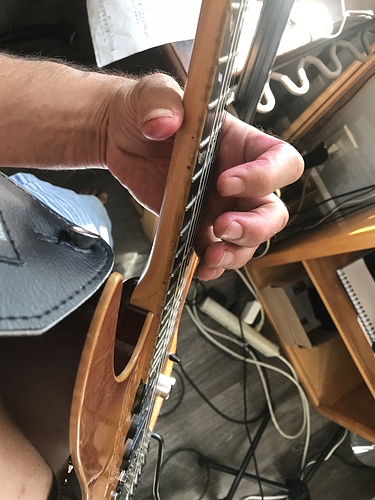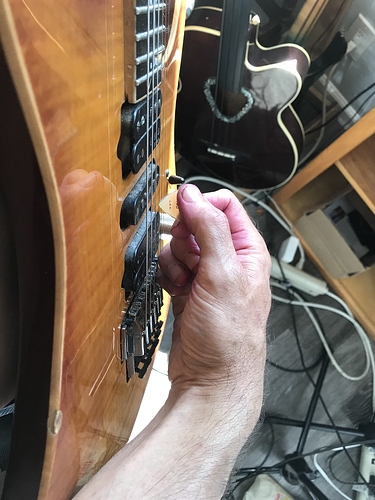Again, If I raise the guitar strap, it starts to hurt my R shoulder, just like when I play seated.
The classical players are the only ones who really solve this problem in a standardized way. They wear the guitar high, with a high neck angle.
Classical players also have a thick classical guitar body that puts the guitar out in front by at least three inches or more. That means the neck is less likely to be smashed against the palm. Why? Because the guitar neck is further out away from the player’s body, thusly creating more space for the throw of the forearm, leaving more room for the hand to be there, not smashed short. Even if you have the dual problems of very broad shoulders and a very flat breastplate, like I do, classical guitar puts the guitar in a good position for playing.
Classical players also don’t normally wear the guitar as they tend to use a foot rest for the lead leg, upon which the guitar body rests.
Classical players seldom play high positions.
Again, my LH problem — hand smashed, bad angle, is in the high positions where the palm is smashed flat against the back of the neck. This is where hand tends to rotate inward, or pronate, where, due to humeral angle, you can’t get the same angle on the neck by forearm supination. If you cannot easily supinate to have the palm face up, there will be difficulty to play 3 note per string scales there. Apparently most people don’t have problems turning their hands to face the sky. For me, that is very hard and also hurts a little (see photo where I strain with about 75% full power to nearly do so).
Where I am trying to supinate the forearm in the high positions, I am very tense. Where I am trying to create space by pulling my shoulder back, by arching my back, by trying to get that guitar out front, I am tense. Too much tension hurts my body and my playing.
It would be easier if the guitar neck were sideways-shifted towards the fretting hand and angled up.
I am NOT saying the thumb needs to be behind the neck ALL THE TIME. But when the palm it is smashed flat; when the wrist is cranked, playing is hard. So how do you make it not smashed flat…………
What I did on that purple guitar was to change the strap buttons. The UPPER button is BEHIND the horn, while the LOWER button is on the top side of the face of the guitar body (fugly but functional). That helps a good bit. By putting the strap button behind the horn, the guitar upper horn (and the guitar neck, by connection), the guitar can travel outwards, away from the player’s body.
You can also see in that Joey Tafolla video how he is using his R forearm to push the guitar body in, thereby making the neck pop outwards more. Yet with that, you can see that the strap button on the upper horn is pulling the guitar back in towards his body. Joey is using his muscle to fight against not only gravity, but also the strap tension.
@BlackInMind is trying to help and posted an awesome video. But my problem is perhaps a bit different and hard to understand.




